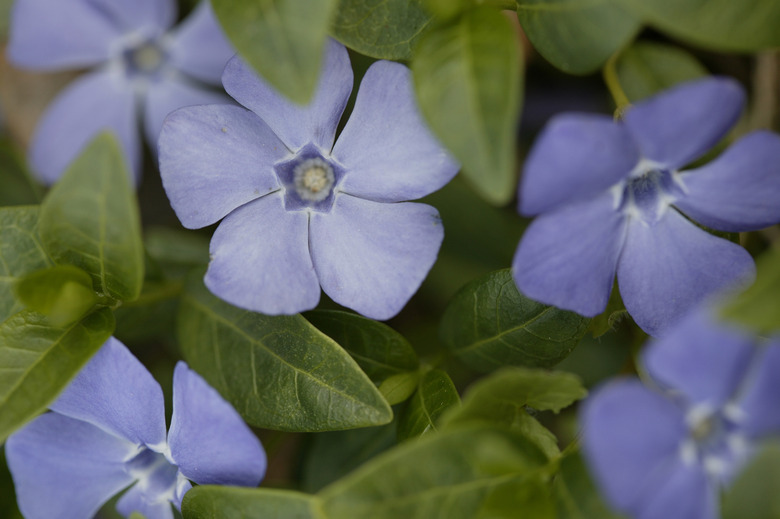Periwinkle Types
Periwinkle (Vinca minor) and greater periwinkle (Vinca major) typically serve as evergreen ground cover in landscapes. Periwinkle is known for its ability to thrive in full to partial shade and putting out small flowers in shades of violet-blue all spring and into early summer. For best results, mow your periwinkle patch every couple of years after the blooms fade. Despite this plant's popularity, it has an aggressive growth habit and is listed as an invasive in some places. (Ref 1-8)
Step 1
Periwinkle (Vinca minor) and "Dart's Blue" (Vinca minor "Dart's Blue") are common varieties of periwinkle that stay true to this perennial plant's typical traits. Periwinkle has deep-blue flowers and spreads 23 to 35 inches. "Dart's Blue" displays light blue flowers, spreads 18 to 23 inches and has slightly larger flowers and leaves. Both plants have small flowers and grow 4 to 6 inches tall in U.S. Department of Agriculture plant hardiness zones 3 through 9.
Step 2
Colorful Foliage
Step 1
Some types of periwinkle feature colorful foliage and grow 4 to 6 inches tall by 23 to 35 inches wide. The green foliage on "Ralph Shugert" (Vinca minor "Ralph Shugert") has distinct white edges and grows in USDA zones 3 through 9. It bears very small bright blue flowers. "Illumination" (Vinca minor "Illumination") has golden-yellow foliage with green edges and bears small deep blue flowers. It grows in USDA zones 4 through 9. Like other types of periwinkle, these plants are good for rock gardens and perform well in containers.
Step 2
- Periwinkle (Vinca minor) and "Dart's Blue" (Vinca minor "Dart's Blue") are common varieties of periwinkle that stay true to this perennial plant's typical traits.
Atypical Flowers
Step 1
Enjoy the very small, atypical flowers on these less common types of periwinkle. "Alba" (Vinca minor "Alba") produces white flowers and "Atroprupurea" (Vinca minor "Atroprupurea") produces deep wine-purple flowers. Both types of periwinkle grow 4 to 6 inches tall by 18 to 23 inches wide in USDA zones 3 through 9. Similar to other types of periwinkle, "Alba" and "Atroprupurea" resist both deer and rabbits.
Greater Periwinkle
Step 1
Greater periwinkle (Vinca major) and its variety "Wojo's Gem" (Vinca major "Wojo's Gem") feature a few different traits than periwinkle (Vince minor). These perennials still grow as ground cover, with the characteristic violet-blue flowers, but thrive in full sun to partial shade and don't have summer blossoms. Greater periwinkle blooms in early to mid-spring, and "Wojo's Gem" bears mid- to late spring flowers among yellow-white foliage edged in green. Both types of greater periwinkle grow 6 to 18 inches tall in USDA zones 7 through 9 and spread indefinitely.
Step 2
Step 3
- Enjoy the very small, atypical flowers on these less common types of periwinkle.
- " Greater periwinkle blooms in early to mid-spring, and "Wojo's Gem" bears mid- to late spring flowers among yellow-white foliage edged in green.
